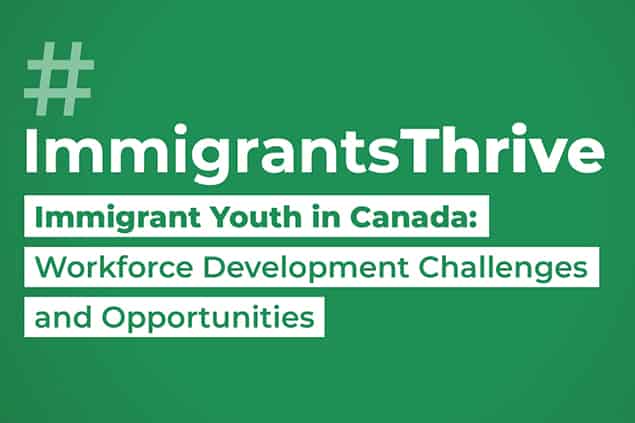Immigrant youth have been among the demographics hit hardest by the COVID-19 pandemic across employment, education, and health (including mental health). The challenges highlighted by the pandemic were not new, but continued long-standing patterns, especially relating to unemployment and underemployment of immigrant youth in Canada.
With this in mind, on March 30, WES convened more than 60 contributors to discuss immigrant youth workforce development in an #ImmigrantsThrive Twitter chat. Influential participants from government, service provision, and post-secondary institutions reviewed the challenges and also opportunities for increased labour market inclusion of immigrant youth. This critical conversation led to such outstanding engagement that the #ImmigrantsThrive hashtag trended at No. 3 in Canada.
Here is a summary of the key themes that emerged from the chat:
1.Unemployment and underemployment of immigrant youth remain a challenge across Canada, and a multi-sector approach with broad stakeholder collaboration is an essential part of the solution. To this end, WES has partnered with the Canadian Council for Youth Prosperity to convene and co-chair a national roundtable on immigrant youth workforce development that brings together service providers, policymakers, employers, and representatives from government, industry, and post-secondary institutions. An example of this type of collaboration was shared by ACCES Employment, which tweeted about its partnership with ESDC, the Ontario Masonry Training Centre, and LiUNA. The partnership is helping newcomer youth prepare for careers in the trades sector.
A1: Collaborations between agencies and services is critical. For example, ACCES working with the ESDC, The Ontario Masonry Training Centre, and LiUNA will help newcomer youth develop a career in the Trades Sector. #ImmigrantsThrive
— ACCES Employment (@ACCESEmployment) March 30, 2021
Success Skills Centre also shared that it delivers hands-on practicum training, mentorship, and networking in collaboration with the National Connector Program, as well as internships in related occupations. The YMCA, TRIEC, and the Centre for Skills Development all also highlighted the importance of partnership and cross-sectoral collaboration.
We deliver Hands-On Practicum training, mentorship and networking in collaboration with the National Connector Program, as well as internships in related occupations #ImmigrantsThrive
— Success Skills Centre (@SuccessSkillsC1) March 30, 2021
2. Youth, and immigrant youth, are well-positioned to leverage the perfect balance of interpersonal and digital skills required for the future of work. SuccessBC pointed out that interpersonal skills are still a key component of immigrant youth workforce development, and we know that demand for digital skills is on the rise. Appropriate assessment and recognition of immigrant youth’s skills is essential for tapping into this underutilized labour pool. Technologies that use artificial intelligence (AI) and digital platforms are especially useful in this assessment and recognition. Consider contributors SkyHive and IEC–BC, both of which have platforms that can identify skills and competencies and increase employer confidence beyond what is possible with traditional résumés or interview practices.
A6: Collaborately help immigrant youth identify paths they can take to actualize their career aspirations. We partner with @issbc's Youth In Tech program to help youth newcomers recognize their capabilities using our core tech and gain exposure to careers in AI. #ImmigrantsThrive
— SkyHive (@SkyHiveAI) March 30, 2021
A2: While technological advancements and digital skills play a prominent role, interpersonal skills are still an integral part of youth development in the workforce. #ImmigrantsThrive
— Javad Soltan (@soltan_javad) March 30, 2021
Not only are immigrant youth comfortable accessing and using platforms likes FAST and ASCEND (IECBC), but in many ways the benefits of these skills identification and assessment technologies are even more beneficial for youth job seekers with limited working experience.
Immigrant youth face many of the same bias and equity challenges that immigrants of all ages face. Many contributors pointed out that immigrant youth are often missing employment opportunities because of name bias, and that the primary solution here is to have employers increase their equity and inclusion efforts. Immigrant youth make up nearly 21 percent of the working youth population of Canada. This is a demographic the Canadian labour market cannot afford to exclude.
A5: Studies are showing that people with "white sounding" names on resumes get more call backs, even when they used the same exact resume but with different names. We have to know this to help them navigate these barriers. #immigrantsthrive
— WILLimmploy (@WILLimmploy) March 30, 2021
Great point! A recent article pointed out that newcomers often change their names to adjust to this bias. It should be the other way around. #ImmigrantsThrive
— Centre for Skills Development (@CentreConnect) March 30, 2021
3. Many international students want to live and work in Canada long-term; increased policy and programmatic initiatives are needed to leverage this growing source of talent. Many contributors pointed out that the higher tuitions international students pay can cause financial instability, not only for students but for their families as well. International students account for almost 40 percent of post-secondary revenue in Canada, paying almost $4 billion in 2018, despite representing only around 12 percent of the total student population. Even with these costs, there is a lack of programming for international students that supports their long-term career aspirations and inclusion in the Canadian labour market.
A1. Tuition fees for international students are much higher than those for domestic students and yet scholarships for international students are fewer. These students often have to work under the table or in unsafe conditions in order to pay the tuition. #ImmigrantsThrive
— YWCA Hamilton (@YWCA_Hamilton) March 30, 2021
A3: Int’l students already contribute $21B to our economy. But the % of int’l students who transition from student visa permanent residency is low. Gaining study-relevant CDN work experience correlates to int’l students’ prospects for settling in Canada #ImmigrantsThrive 1/2
— TRIEC (@TRIEC) March 30, 2021
A3 2/2: Research shows that such opportunities are crucial for gaining relevant professional experience: this might help explain some of the earnings gap between Canadian and international students graduating from #PSE: https://t.co/8gQLgupSwh #ImmigrantsThrive
— Steven Tobin (@realsteventobin) March 30, 2021
Q3: Need to take a long-term lens & support early settlement & integration. Can't view it only from economic lens. If Canada wants to retain international students, then we need to ensure they have the supports in place to establish their lives here. #ImmigrantsThrive
— S.U.C.C.E.S.S. (@SUCCESSCanada) March 30, 2021
How Can You Get Involved in the Ongoing Immigrant Youth Work of WES?
In addition to the Immigrant Youth Workforce Development Roundtable, WES continues to engage employers and partners in industry and direct service provision to identify and test efforts that support labour market inclusion of immigrant youth. Here are some ways stakeholders, including post-secondary institutions, can engage with the ongoing immigrant youth work of WES:
- Provide insights into service delivery challenges, trends, and patterns as well as proven strategies for increasing immigrant youth engagement.
- Collaborate to increase access to experiential learning programs and pilots, including co-ops and work-integrated learning opportunities for immigrant youth.
- Increase the availability of data and evidence on immigrant youth demographics, challenges, and labour market inclusion outcomes by partnering with WES Global Talent Bridge.
For more information, and to get involved, please contact program lead Shaunna-Marie Kerr.



